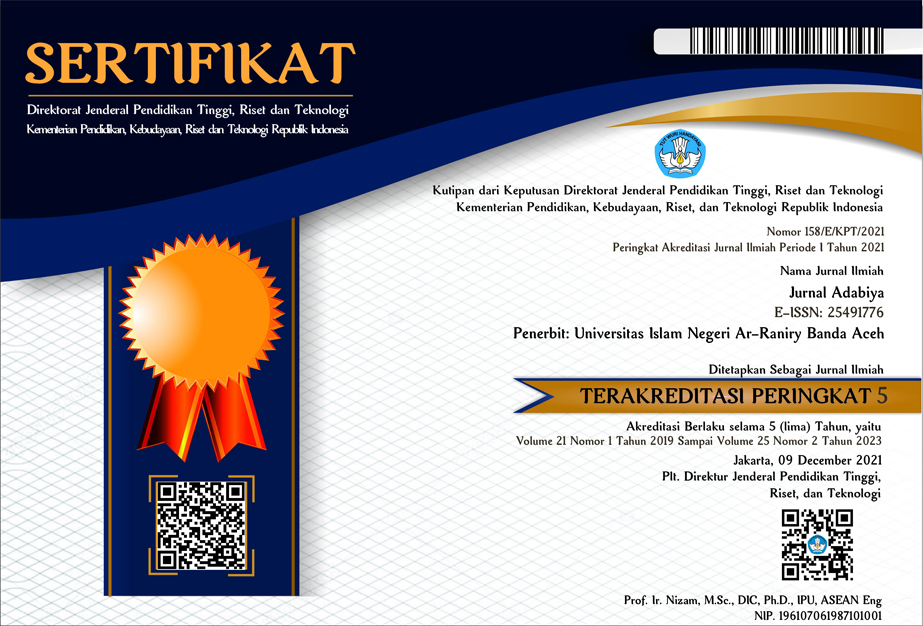Kemajuan dan Kemunduran Peradaban Islam di Eropa (711M-1492M)
Abstract
Spain is more commonly known as Andalusia, the Andalusia comes from the word Vandalusia, which means the country of the Vandals, because the southern part of the Peninsula was once ruled by the Vandals before they were defeated by Western Gothia in the fifth century. This area was ruled by Islam after the rulers of The Umayyah seized the peninsula's land from the West Gothies during the time of the Caliph Al-Walid ibn Abdul Malik. Islam entered Spain (Cordoba) in 93 AH (711 AD) through the North African route under the leadership of Tariq bin Ziyad who led the Islamic army to conquer Andalusia. Before the conquest of Spain, Muslims had taken control of North Africa and made it one of the provinces from the Umayyad Dynasty. Full control of North Africa took place in the days of Caliph Abdul Malik (685-705 AD). Conquest of the North African region first defeated until becoming one of the provinces of the Umayyad Caliph spent 53 years, starting from 30 H (Muawiyah ibn Abi Sufyan's reign) to 83 H (al-Walid's period). Before being defeated and then ruled by Islam, in this region there were sacs which became the basis of the power of the Roman Empire, namely the Gothic Kingdom. In the process of conquering Spain there were three Islamic heroes who could be said to be the most effective in leading units of troops there. They are Tharif ibn Malik, Tariq ibn Ziyad, and Musa ibn Nushair. Subsequent territorial expansion emerged during the reign of Caliph Umar ibn Abdil Aziz in the year 99 AH/717 AD, with the aim of controlling the area around the Pyrenian mountains and South France. The second largest invasion of the Muslims, whose movement began at the beginning of the 8th century AD, has reached all of Spain and reached far to Central France and important parts of Italy. The victories achieved by Muslims appear so easy. It cannot be separated from the existence of external and internal factors. During the conquest of Spain by Muslims, the social, political and economic conditions of this country were in a sad state. Politically, the Spanish region was torn apart and divided into several small countries. At the same time, the Gothic rulers were intolerant of the religious beliefs adopted by the rulers, namely the Monophysites, especially those who adhered to other religions, Jews. Adherents of Judaism, the largest part of the Spanish population, were forced to be baptized to Christianity. Those who are unwilling brutally tortured and killed. The people are divided into the class system, so that the situation is filled with poverty, oppression, and the absence of equality. In such situations, the oppressed await the arrival of the liberator and the liberator was from Muslims. Warrior figures and Islamic soldiers who were involved in the conquest of Spain are strong figures, their soldiers are compact, united, and full of confidence. They are also capable, courageous, and resilient in facing every problem. Equally important are the teachings of Islam shown by the Islamic soldiers, like tolerance, brotherhood, and help each other. The attitude of tolerance of religion and brotherhood contained in the personalities of the Muslims caused the Spanish population to welcome the presence of Islam there. Since the first time Islam entered in the land of Spain until the collapse of the last Islamic empire was about seven and half centuries, Islam played a big role, both in fields of intellectual progress (philosophy, science, fiqh, music and art, language and literature) and the splendor of physical buildings (Cordova and Granada). The long history passed by Muslims in Spain can be divided into six periods. Spanish Muslims reached the peak of progress and glory rivaled the glory of the Abbasid sovereignty in Baghdad. Abdurrahman Al-Nasir founded the Cordova University. He preceded Al-Azhar Cairo and Baghdad Nizhamiyah.
Keywords
Full Text:
PDFReferences
As-Siba’i Mustafa, Peradaban Islam Dulu, Kini dan Esok. Gema Insani Press, Jakarta : 1993
Yatim Badri, Sejarah Peradaban Islam, PT: Gravindo Persada : 2003
Majid Mun’im Abdul, Sejarah Kebudayaan Islam, Pustaka : 1997
Perpustakaan Nasional : Katalog Dalam Terbitan (KDT), Ensiklopedi Mini Sejarah dan Kebudayaan Islam, Logos Wacana Ilmu, Jakarta 1996.
Sunanto Musyrifah, Sejarah Islam Klasik, Jakarta Timur, Penada Media: 2003
Suwito, Sejarah Sosial Pendidikan Islam, Jakarta, Kencana. 2005
Dean Derhak, Muslim Spain and European Culture, dalam http://www.muslimheritage.com
Philip K. Hitti, History of the Arab, London, Macmillan Press, 1970
Carl, Brockelmann, History of the Islami Peoples, London: Rotledge & Kegan Paul, 1980
Bertol Spuler, The Muslim World: A Hisrorical Survey, Leiden: E. J. Bril, 1960
Thomas W. Arnold, Sejarah Da’wah Islam, Jakarta: Wijaya, 1983
K. Bertens, Ringkasan Sejarah Filsafat, Yogyakarta: Kanisius, 1986
Mahmudunnasir, Islam Its Concept & History, New Delhi: Kitab Bravan, 1981
S. M. Imaduddin, Muslim Spain: 711-1492 A.D, Leiden: E. J. Brill, 1981
Jurji Zaidan, Tarikh al-Tamaddun al-Islami, juz III, Kairo: Dara l-Hilal, tt
Musyrifah Sunanto,Sejarah Islam Klasik, Jakarta Timur, Penada Media, 2003
W. Montgomery Watt, Kejayaan Islam: Kajian kritis dari tokoh orientalis. Yogyakarta: Tiara Wacana, 1990
Harun Nasution, Islam ditinjau dari berbagai aspeknya, Jakarta: UI Press, 1985
Lutfi abd al-Badi, al-Islam fi Isbaniya, Kairo: Maktabah al-Nahdhah al-Mishriyyah, 1969
Masjid fakhri, Sejarah Filsafat Islam, Jakarta: Pustaka jaya, 1986
Zainal Abidin Ahmad, Riwayat Hidup Ibn Rusyd, Jakarta: Bulan Bintan: 1975
DOI: http://dx.doi.org/10.22373/adabiya.v21i1.6454
Refbacks
- There are currently no refbacks.
All papers published in Jurnal Adabiya are licensed under a Creative Commons Attribution-ShareAlike 4.0 International License. |















_(4)1.png)





